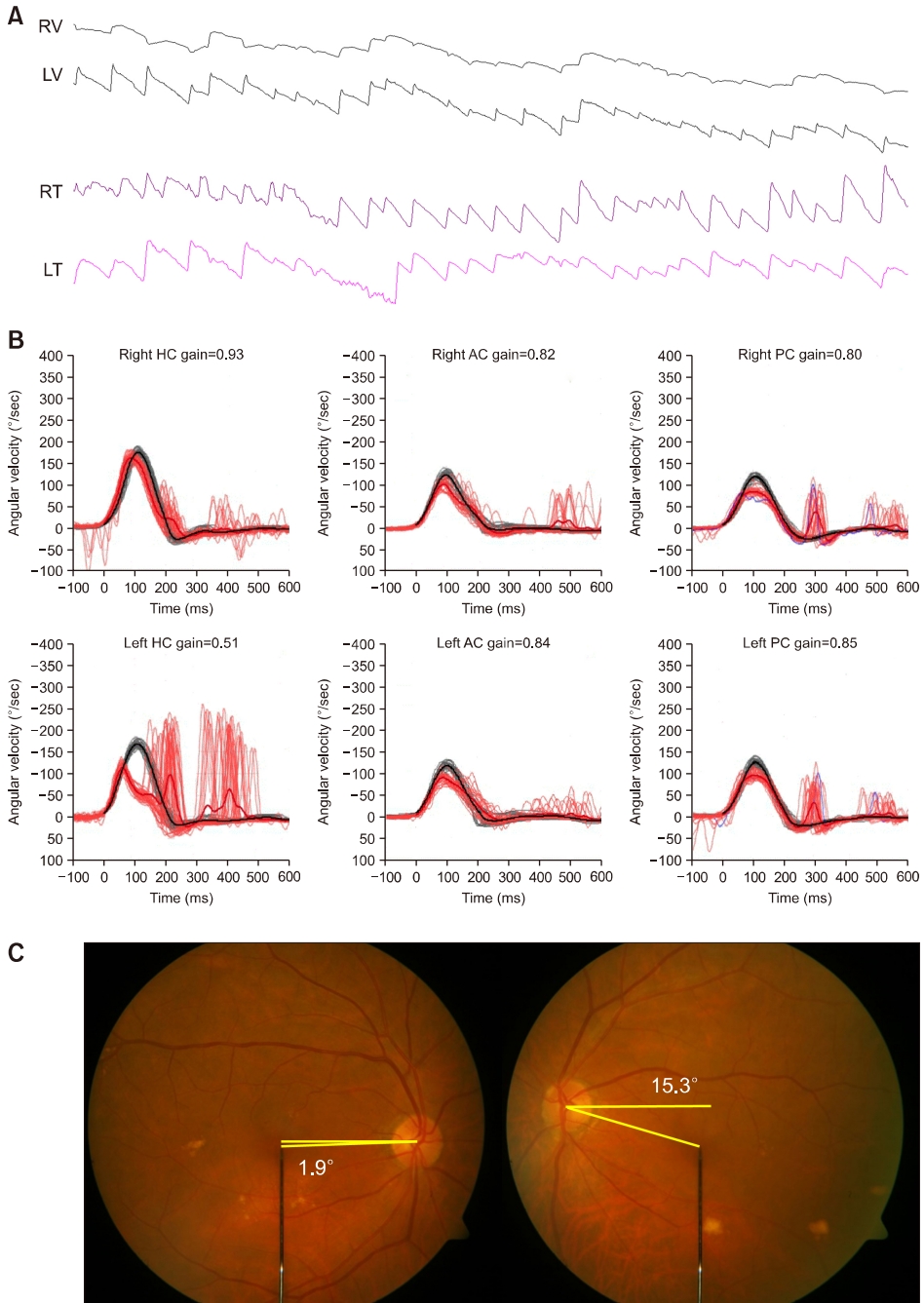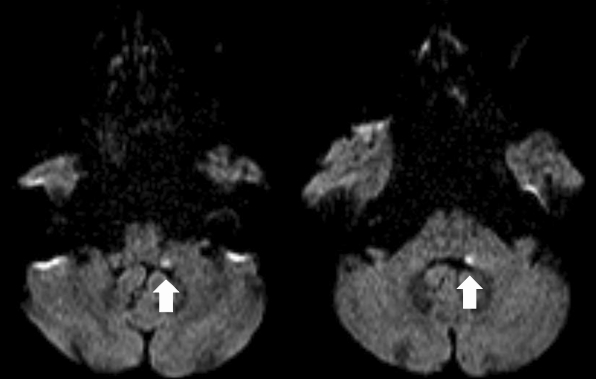Articles
- Page Path
- HOME > Res Vestib Sci > Volume 21(1); 2022 > Article
-
Case Report
전정신경핵 병터에서 발생한 해리성 수직-회선안진 -
김현성1, 오은혜1, 최재환1,2

- Dissociated Vertical-Torsional Nystagmus in Vestibular Nucleus Lesion
-
Hyun-Sung Kim1, Eun Hye Oh1, Jae-Hwan Choi1,2

-
Research in Vestibular Science 2022;21(1):19-23.
DOI: https://doi.org/10.21790/rvs.2022.21.1.19
Published online: March 15, 2022
1Department of Neurology, Pusan National University Yangsan Hospital, Yangsan, Korea
2Department of Neurology, Pusan National University College of Medicine, Yangsan, Korea
- Corresponding Author: Jae-Hwan Choi Department of Neurology, Pusan National University Yangsan Hospital, 20 Geumo-ro, Mulgeum-eup, Yangsan 50612, Korea Tel: +82-55-360-2122 Fax: +82-55-360-2152 E-mail: rachelbolan@hanmail.net
• Received: February 14, 2022 • Revised: February 23, 2022 • Accepted: March 2, 2022
Copyright © 2022 by The Korean Balance Society. All rights reserved.
This is an open access article distributed under the terms of the Creative Commons Attribution Non-Commercial License (http://creativecommons.org/licenses/by-nc/4.0) which permits unrestricted non-commercial use, distribution, and reproduction in any medium, provided the original work is properly cited.
- 2,606 Views
- 75 Download
Abstract
- Dissociated vertical-torsional nystagmus is a unique form of nystagmus characterized by conjugate torsional but disparate vertical components. It has been mainly reported in internuclear ophthalmoplegia or medial medullary lesion involving the medial longitudinal fasciculus (MLF). The patterns of the nystagmus may be explained by a disruption of vestibulo-ocular reflex pathways from vertical semicircular canal or utriculo-ocular reflex within the MLF, but it is debatable. We described a dissociated upbeat-torsional nystagmus in a patient with vestibular nucleus infarction without involvement of MLF.
서 론
증 례
고 찰
Acknowledgments
Fig. 1.(A) Eye-movement recordings show asymmetric contraversive (clockwise from the patient’s perspective, right eye>left eye) torsional nystagmus with markedly asymmetric upbeat (left eye>right eye) components. (B) Video head impulse tests show decreased vestibulo-ocular reflex gains for the left horizontal semicircular canal (HC) and both posterior semicircular canals (PCs) with corrective catch-up saccades. (C) Fundus photography demonstrates an extorsion of the left eye (15.3°; normal range, 0°–12.6°). RV, vertical position of the right eye; LV, vertical position of the left eye; RT, torsional position of the right eye; LT, torsional position of the left eye.


Fig. 2.Follow-up diffusion-weighted magnetic resonance imaging 2 days later disclose a small acute infarction (arrows) along the dorsolateral portion of the rostral medulla and caudal pons.


- 1. Leigh RJ, Zee DS. The neurology of eye movements. 5th ed. Oxford: Oxford University Press; 2015.
- 2. Jeong SH, Kim EK, Lee J, Choi KD, Kim JS. Patterns of dissociate torsional-vertical nystagmus in internuclear ophthalmoplegia. Ann N Y Acad Sci 2011;1233:271–8.ArticlePubMed
- 3. Lee SU, Park SH, Jeong SH, Kim HJ, Kim JS. Evolution of torsional-upbeat into hemi-seesaw nystagmus in medial medullary infarction. Clin Neurol Neurosurg 2014;118:80–2.ArticlePubMed
- 4. Choi KD, Jung D S, Park KP, Jo JW, Kim JS. Bowtie and upbeat nystagmus evolving into hemi-seesaw nystagmus in medial medullary infarction: possible anatomic mechanisms. Neurology 2004;62:663–5.ArticlePubMed
- 5. Choi JH, Seo JD, Choi Y R, Kim MJ, Kim HJ, Kim JS, et al. Inferior cerebellar peduncular lesion causes a distinct vestibular syndrome. Eur J Neurol 2015;22:1062–7.ArticlePubMed
- 6. Kim HJ, Lee SH, Park JH, Choi JY, Kim JS. Isolated vestibular nuclear infarction: report of two cases and review of the literature. J Neurol 2014;261:121–9.ArticlePubMed
- 7. Chang TP, Wu YC. A tiny infarct on the dorsolateral pons mimicking vestibular neuritis. Laryngoscope 2010;120:2336–8.ArticlePubMed
- 8. Ataç C, Kısabay A, Çetin Akkoç C, Saruhan G, Çelebisoy N. Vestibular nuclear infarction: case series and review of the literature. J Stroke Cerebrovasc Dis 2020;29:104937. ArticlePubMed
- 9. Kim CH, Choi KD. Aperiodic alternating nystagmus in isolated vestibular nucleus infarction. J Neurol 2019;266:2875–7.ArticlePubMed
- 10. D as V E, Leigh RJ, Sw ann M, Thurtell MJ. Muscimol inactivation caudal to the interstitial nucleus of Cajal induces hemi-seesaw nystagmus. Exp Brain Res 2010;205:405–13.ArticlePubMedPMC
REFERENCES
Figure & Data
References
Citations
Citations to this article as recorded by 

- Figure
- We recommend
- Related articles
-
- Positional Dizziness and Vertigo without Nystagmus and Orthostatic Hypotension
- Clinical Significance of Spontaneous Nystagmus Frequency in Vestibular Neuronitis
- Central Positional Nystagmus from Focal Brain Lesion
- Periodic Alternating Nystagmus in Focal Cerebellar Lesion
- Tilt Suppression of the Post-rotatory Nystagmus in Cerebellar Nodular Lesions

 KBS
KBS
 PubReader
PubReader ePub Link
ePub Link Cite
Cite



